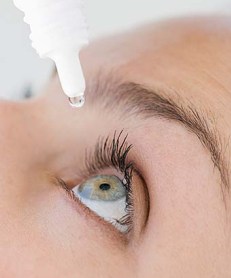 Dry Eye Syndrome
Dry Eye Syndrome
Red, gritty and scratchy eyes can have a number of causes and possible treatments. In addition to discomfort and fluctuating vision, dry eyes can lead to styes and infection. Regular eye examinations can prevent complications and provide the opportunity for you to get help with treatment.
If you have dry eyes, you may notice that the discomfort worsens as the day progresses. Air conditioning, smoke, drafts, and cold temperatures become difficult to tolerate. It may feel like there’s a foreign body in your eye, or your eyes may have a sandy feeling. In spite of the fact that you are suffering from “dry” eyes, you may find that your eyes are watering reflexively and that strands of mucous are accumulating.
What’s Going On? Normal tear film consists of three layers: mucin, aqueous, and lipid. Abnormalities in production, content, or distribution of these three layers or in eyelid function will cause the various conditions commonly known as dry eye.
- Lipid Problems: These are the most common cause of dry eye. Glands in the eyelid produce lipids. Greasy lotions, incomplete removal of makeup, or skin conditions like dandruff can plug the glands and prevent lipids from secreting.
- Aqueous Deficiency: This can be a side effect of certain medications you’re taking. The culprits include antihistamines, diuretics, hormones, and psychotropics.
- Mucin Deficiency: Chronic infection or trauma to the eye can cause a lack of mucin. Autoimmune diseases negatively effect the mucin layer too.
- Eyelid Problems: The eyelid may turn in or out as a result of the aging process or of scarring. Tears then spill over the eyelid, allowing the eye to become dry. Depending on the severity of the situation, this problem can be treated with plastic surgery.
Also, dry eye can be aggravated by inflammation of the eyelid margin. In this case, the lid, where the eyelashes attach, will be red and irregular.
No one treatment for dry eye has proven completely successful. A combination of the following may improve comfort: good eyelid hygiene, the use of artificial tears and lubricating ointments, newer agents designed to heal tissue such as Cyclosporine, supplements and punctal occlusion (the insertion of a silicone plug into the tiny opening that drains the tears). Examining controllable factors such as medications, topical creams and lotions, and environment enhances treatment success.